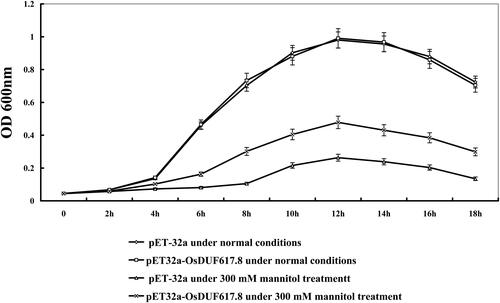Abstract
With the advance of sequencing technology, the number of sequenced genomes has been rapidly increasing. However, the functions of a large number of genes, including gene families with domains of unknown functions (DUF), still remain unclear. In this study, we analysed eight members of OsDUF617 (OsDUF617.1-OsDUF617.8) in rice Nipponbare. By phylogenetic analysis, all these OsDUF617 proteins could be classified into three major groups (I, II, III). We used real-time polymerase chain reaction to examine the expression of all these OsDUF617 members in 15 distinct rice tissues. The expression of these members under various abiotic stress and abscisic acid (ABA) conditions was also examined. Under drought conditions, the expression level of OsDUF617.8 in rice was significantly elevated. Overexpression of OsDUF617.8 in Escherichia coli led to a significant enhancement of catalase (CAT) and peroxidase (POD) activities, and improved bacterial resistance to osmotic stress. The results of this study will provide important information for further study of the function of the OsDUF617 family in rice.
Supplemental data for this article is available online at 10.1080/13102818.2021.1934541.
Keywords:
Introduction
In the process of growth and development, plants often face various unfavourable environmental conditions. These adverse environmental conditions include biotic stress, such as pathogen infection and herbivore attack, and abiotic stress, such as drought, high salt, cold and heat. Abiotic stresses not only affect the normal growth and development of plants, but also have a significant impact on plant productivity and crop quality [Citation1,Citation2]. According to statistics, about 70% of the yield reduction is directly caused by the negative impact of abiotic stress on crops [Citation3]. To avoid being affected by these abiotic stress factors, the plants themselves have gradually formed corresponding complex physiological mechanisms to cope with adverse environmental conditions [Citation4,Citation5]. Among these abiotic stresses, drought is a major constraint to rice production worldwide [Citation6]. Drought stress causes osmotic stress, and leads to cellular dehydration [Citation7]. Another consequence is the production of reactive oxygen species, which then in turn affects cellular structures and metabolism negatively [Citation8]. Plants adapt to drought stress by attenuated growth, the activation/increased expression or induction of genes, transient increases in ABA levels, accumulation of compatible solutes and protective proteins, increased levels of antioxidants and suppression of energy-consuming pathways [Citation7]. In recent years, some success in improving the drought stress tolerance of plants has been achieved [Citation9–15]. However, the regulatory mechanisms involved in drought stress tolerance are not fully understood.
The domain of unknown function (DUF) is a protein domain that has no characterized function. The unknown domain functional protein family, or DUFs, currently contains more than 4000 families representing over 22% of known families [Citation16]. These families are highly conserved and have been collected together in the Pfam database (http://pfam.xfam.org/family) using the prefix DUF followed by a number. Studies have shown that DUFs exist in a wide range of organisms, including eukaryotes, prokaryotes and fungi [Citation17]. At present, the functions of only a few DUF proteins have been elucidated recently. Some members of DUF231, DUF724, DUF1218 and DUF784 families play important roles in plant growth and development [Citation18–21], while some other DUF-containing proteins are involved in stress response [Citation22–27].
The OsDUF617 family consists of plant proteins of unknown specific function domain with an average length of approximately 158 amino acid residues. There are twelve DUF617 members in Arabidopsis. The role of all DUF617 family members in plants is not known yet. In this study, we analysed the protein sequence of OsDUF617 family in rice, their spatio-temporal expression profile and their expression pattern under various stresses and abscisic acid (ABA). Furthermore, we overexpressed gene OsDUF617.8 in E. coli and found that overexpression of OsDUF617.8 in E. coli could improve the tolerance to osmotic stress. The results of the work also may provide new insights into the function of the DUF617 family in plants.
Materials and methods
Database searches
All the sequences of assumed OsDUF617 family proteins in rice were obtained by retrieving the rice genome annotation project (RGAP version 7) database (http://rice.plantbiology.msu.edu/) with domain number PF04759. Then downloaded all the related protein sequences of the OsDUF617 family from RGAP and confirmed with the SMART database (http://smart.embl-heidelberg.de/smart/batch.pl) [Citation28]. Twelve DUF617 members’ sequences in Arabidopsis were also downloaded from the Arabidopsis information resource (https://www.arabidopsis.org). If there were several gene models at one locus, then only the complete gene model was selected for further sequence analysis.
Sequence analysis
All the OsDUF617family members’ information, such as chromosomal localization, amino acid length, full-length cDNA accessions, etc., was obtained from the rice genome annotation project (http://rice.plantbiology.msu.edu/). The protein localization of OsDUF617 members was predicted by online protein location prediction software Plant-PLoc 2.0 (http://www.csbio.sjtu.edu.cn/bioinf/plant-multi/) [Citation29]. The multiple sequence alignment analysis of the OsDUF617 members was performed using Clustal Omega (https://www.ebi.ac.uk/Tools/msa/clustalo). In order to understand the evolutionary relationship among members of DUF617, we constructed a neighbor-joining (NJ) phylogenetic tree with 1000 bootstrap replicates using MEGA4 [Citation30]. The unrooted tree was generated by the maximum-likelihood method.
Plant growth
Rice (Oryza sativa L. subsp. japonica cv. Nipponbare) seeds were germinated for 3 days before they were transferred to a 30-L nutrient solution container for hydroponic growth [Citation31]. Fifteen different tissues of rice Nipponbare under normal conditions were sampled, as follows: Lb1, leaf blade at the four-leaf stage; Lb2, leaf blade from plants with four tillers; Lb3, leaf blade at the ripening stage; Ls1, leaf sheath at the four-leaf stage; Ls2, leaf sheath from plants with four tillers; Rt1, root at the four-leaf stage; Rt2, root from plants with four tillers; St1, stem from plants with four tillers; St2, stem at the ripening stage; An, 1.2–1.5 mm anther; Pi, pistil from 10–14 cm inflorescence; Em1, embryo at 7 days after flowering; Em2, embryo at 28 days after flowering; En1, endosperm at 7 days after flowering; En2, endosperm at 28 days after flowering.
Various stresses and ABA treatment
When the fourth leaf of rice seedlings appeared, they were treated with various stresses and ABA. For the salt treatment, high salinity stress was achieved by adding NaCl to the solution to a final concentration of about 200 mmol/L. For the drought tests, intact seedlings were put in the air without water supply. For the cold tests, the seedlings were transferred to a chamber at 4 °C (12-h-light/12-h-dark cycle). For ABA treatment, 100 μmol/L ABA was sprayed onto the leaves of seedlings. For heat treatment, the seedlings were exposed to 42 °C. Stress treatment continued until the seedlings were sampled. For salt stress and drought stress, seedlings were sampled at 0, 4, 8 and 16 h. For ABA, heat and cold stress, seedlings were sampled at 0, 1, 3, 8 h after treatment.
RNA extraction and real-time polymerase chain reaction
The total RNA was extracted using Trizol reagent (GIBCO, Burlington, ON, USA) according to the instructions. In order to degrade any possible DNA contamination in total RNA, total RNA was treated with RNase-free DNase for 15 min. Real-time PCR was performed as described before [Citation32]. The rice Actin1 gene (LOC_Os03g50885) was used as an internal control with primers 5′-TGGCATCTCTCAGCACATTC-3′ and 5′-TGCACAATGGATGGGCCAGA-3′. The primers used in the expression analysis of the OsDUF617 gene family members are listed in (supplementary material). The 2-△△Ct method was used to analyse the relative expression data as mentioned previously [Citation33].
Table 1. OsDUF617 genes and the properties of the putative proteins they encode.
Assay for osmotic stress tolerance of E. coli transformants
In order to construct the expression vector pET32a-OsDUF617.8, specific primers were designed as follows: sense, 5′-GGATCCATGCCGTCCTTCGTCGACGG-3′ (BamHI site underlined) and antisense, 5′-AAGCTTTCATTTCATCCTCACTAGGA-3′ (HindIII site underlined). The amplified products were cloned into a pET32a vector at the BamHI-HindIII site to express the fusion protein, which has a Trx•Tag™ thioredoxin at the N-terminus [Citation34]. The transformed E. coli Rosetta cells (Sanborn, MN, USA) were grown in Luria–Bertani (LB) liquid medium containing 100 µg/mL of ampicillin at 37 °C overnight. Then they were inoculated into fresh LB medium (1:100 dilution) supplemented with ampicillin (100 µg/mL) to be incubated until the exponential growth phase (optical density at 600 nm of 0.5–0.6). Isopropylthio-β-D-galactoside (IPTG) was added into the cultures to induce the expression of the transformed gene. For the osmotic stress tolerance assay, the growth curve of E. coli transformants was plotted. The OD values (at 600 nm) of pET-32a, pET32a-OsDUF617.8 cells were measured (DU 800 spectrophotometer, Beckman coulter, USA) at 0, 2 h, 4 h, 6 h, 8 h, 10 h, 12 h, 14 h, 16 h and 18 h under normal conditions and 300 mmol/L mannitol treatment.
Measurements of antioxidant enzyme activity
The bacteria were collected by centrifugation. After ultrasonic cell-breakage at 4 °C, the supernatant (as a crude enzyme solution) was collected by spinning at 12 000 rpm (13200 g rcf) for 20 min. CAT, SOD and POD activities were determined as described previously [Citation35]. One unit SOD activity was defined as the amount of enzyme required to result in a 50% inhibition of the rate of NBT (p-Nitro-Blue tetrazolium chloride) reduction measured at 560 nm. Absorbance change of the brown guaiacol at 460 nm was recorded for calculating POD activity. CAT activity was assayed by monitoring the decrease in absorbance at 240 nm as a consequence of H2O2 consumption.
Data analysis
The experiment was arranged as a completely randomized design and all the experiments were repeated three times. Data are mean values from three independent experiments, with standard error of the means. Statistical analysis was performed using the Student’s t-test by EXCEL version 2003.
Results
Identification and sequence analysis of OsDUF617 family members in rice
We searched the rice genome annotation project (RGAP) using domain number PF04759 and obtained eight members of the OsDUF617 family. These OsDUF617 family members were confirmed by the SMART database (). The eight genes are named OsDUF617.1 to OsDUF617.8 according to their position on the pseudomolecules (). These members are distributed on chromosome 1 (OsDUF617.1 and OsDUF617.2), chromosome 2 (OsDUF617.3), chromosome 4 (OsDUF617.4), chromosome 5 (OsDUF617.5), chromosome 6 (OsDUF617.6), chromosome 8 (OsDUF617.7) and chromosome 9 (OsDUF617.8) (). Other information about the OsDUF617 family, including the amino acid length, full length cDNA accessions, molecular weights (MW), isoelectric points (pI) and subcellular localizationis, is listed in . The predicted length of the OsDUF617 proteins varies from 244 (OsDUF617.8) to 315 (OsDUF617.7) amino acids (). The protein localization of all the members of OsDUF617 family was predicted by online protein location prediction software Plant-PLoc 2.0. OsDUF617.1 is located in the chloroplast, nucleus and peroxisome; OsDUF617.2 is located in the nucleus; OsDUF617.3, OsDUF617.5 and OsDUF617.8 are located in the chloroplast; OsDUF617.4 is located in the cell membrane and chloroplast; OsDUF617.6 and OsDUF617.7 are located in the chloroplast and nucleus.
Figure 1. Phylogenetic relationship of OsDUF617 members in rice and twelve DUF617 members in Arabidopsis.
Note: The unrooted tree was generated using MEGA4.0 program by the maximum-likelihood method.
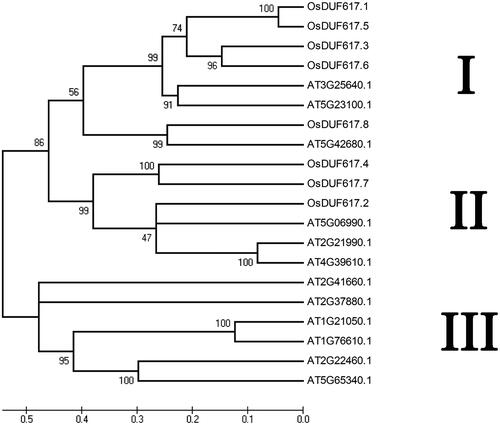
The multiple sequence alignment analysis of the OsDUF617 members was performed using Clustal Omega (https://www.ebi.ac.uk/Tools/msa/clustalo) (). The percent identity of the OsDUF617 family members varies from 31.80% (OsDUF617.3 and OsDUF617.4) to 82.58% (OsDUF617.1 and OsDUF617.5). The phylogenetic analysis was carried out to examine the evolutionary relationship among DUF617 family members in rice and Arabidopsis. Here, the reference sequence includes twelve Arabidopsis DUF617 members. The results showed that all the members of the DUF617 family can be divided into three major groups (I, II, III) (). Group I consists of 5 members of OsDUF617 family in rice and 3 members of DUF617 family in Arabidopsis. Group II contains 3 members of Arabidopsis DUF617 and 3 members of rice OsDUF617. Groups III include 6 members in Arabidopsis. OsDUF617.1 and OsDUF617.5 have the highest similarity in the sequences and they are very close in terms of evolutionary relationship.
Figure 2. Real-time PCR analysis of OsDUF617 genes in different tissues of Nipponbare rice. Fifteen representative tissues are as follows: Lb1, leaf blade at four-leaf stage; Lb2, leaf blade from plants with four tillers; Lb3, leaf blade at ripening stage; Ls1, leaf sheath at four-leaf stage; Ls2, leaf sheath from plants with four tillers; Rt1, root at four-leaf stage; Rt2, root from plants with four tillers; St1, stem from plants with four tillers; St2, stem at ripening stage; An, 1.2–1.5 mm anther; Pi, pistil from 10–14 cm inflorescence; Em1, embryo at 7 days after flowering; Em2, embryo at 28 days after flowering; En1, endosperm at 7 days after flowering; En2, endosperm at 28 days after flowering.
Note: The rice Actin1 transcript levels were used as internal controls. Error bars indicate standard error of the means based on three biological replicates.
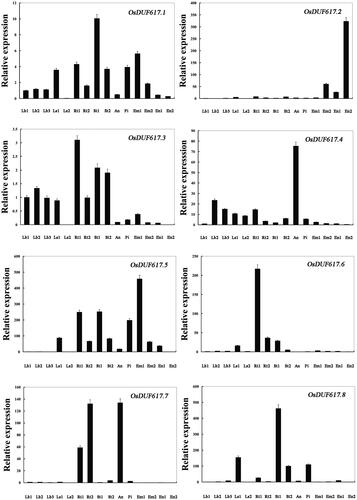
Expression patterns of OsDUF617 family members
So far, to our knowledge, no study has been done about the expression patterns of OsDUF617 family members. Therefore, we used real-time PCR to investigate the expression patterns of OsDUF617 members in 15 samples from different tissues or stages (). The results showed that the expression patterns of these OsDUF617 family members are completely different in different tissues (). For OsDUF617.1, the highest expression was in the St1 (stem from plants with four tillers), whereas the lowest expression was in the Ls2 (leaf sheath from plants with four tillers). For OsDUF617.2, the gene was preferentially expressed in tissues at the ripening stage, such as Em2 (embryo at 28 days after flowering), En1 (endosperm at 7 days after flowering) and En2 (endosperm at 28 days after flowering). For OsDUF617.3, OsDUF617.4 and OsDUF617.5, the highest expression was in the Rt1 (root at the four-leaf stage), An (1.2–1.5 mm anther) and Em1 (embryo at 7 days after flowering), respectively. The OsDUF617.6 gene was preferentially expressed in Ls1 (leaf sheath at the four-leaf stage), Rt1 (root at the four-leaf stage), Rt2 (root from plants with four tillers) and St1 (stem from plants with four tillers). The OsDUF617.7 gene was preferentially expressed in Rt1 (root at the four-leaf stage), Rt2 (root from plants with four tillers) and An (1.2–1.5 mm anther). The OsDUF617.8 gene was preferentially expressed in Ls1 (leaf sheath at the four-leaf stage), St1 (stem from plants with four tillers), St2 (stem at the ripening stage) and Pi (pistil from 10–14 cm inflorescence).
The expression of the OsDUF617 family members was also examined under various stress conditions and ABA treatment (). The expression level of the OsDUF617.1 gene was approximately constant under drought, salt, cold, heat stress conditions and ABA treatment. The expression levels of OsDUF617.2, OsDUF617.4 and OsDUF617.7 displayed a significant decrease (p < 0.01) under heat stress conditions. The expression of OsDUF617.3 was significantly (p < 0.01) upregulated under drought conditions, yet significantly (p < 0.01) downregulated under cold and heat conditions. The expression of OsDUF617.5 was significantly (p < 0.01) upregulated under heat stress conditions and the expression of OsDUF617.6 was significantly (p < 0.01) downregulated under cold conditions. For OsDUF617.8, the expression was significantly (p < 0.01) upregulated under drought, salt and ABA treatment, but significantly (p < 0.01) downregulated under heat conditions.
Figure 3. Relative expression levels of OsDUF617 genes in Nipponbare rice seedlings at the emergence of the fourth leaf under various stress conditions and ABA treatment detected by real time PCR. D, drought; S, salt; C; cold; H, heat and A, ABA.
Note: For salt stress and drought stress, seedlings were sampled at 0, 4, 8 and 16 h. For ABA, heat and cold stress, seedlings were sampled at 0, 1, 3 and 8 h. The rice Actin1 transcript levels were used as internal controls. Error bars indicate standard error of the means based on three biological replicates. **, P < 0.01 (Student’s t-test).
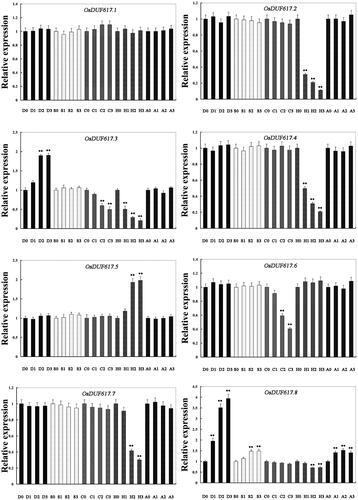
OsDUF617.8 improved osmotic stress resistance in transgenic E. coli
Based on the fact that the expression levels of OsDUF617.8 were significantly elevated under drought conditions, we speculated that this gene may be involved in the response to osmotic stress. We overexpressed the gene in E. coli and then examined the resistance of recombinant bacteria to osmotic stress. Under normal conditions, there was no evident difference in the number of colonies between transgenic lines (E. coli transformed with pET32a-OsDUF617.8) and the control (E. coli transformed with pET-32a). However, under osmotic stress conditions, the growth rate in E. coli transformed with pET32a-OsDUF617.8 was much higher than that of the control from 4 to 18 h (). This result indicated that the overexpression of OsDUF617.8 in E. coli may significantly improve the resistance to osmotic stress.
OsDUF617.8 improves the antioxidant defenses of E. coli transformants grown under osmotic stress conditions
In order to investigate the effects of OsDUF617.8 on the intracellular antioxidant ability, we determined the catalase (CAT), superoxide dismutase (SOD) and peroxidase (POD) activities of E. coli transformants and control bacteria. Under normal conditions, there was no evident difference in CAT, SOD and POD activities between transgenic lines and the control. Under osmotic stress conditions, there was no significant difference in SOD activity, while CAT and POD activities of E. coli transformed with pET32a-OsDUF617.8 were significantly (p < 0.01) higher than those of the control from 4 to 8 h (). These results indicated that the improvement in tolerance to stress in E. coli OsDUF617.8 transformants may be related to the increase in the activities of CAT and POD under osmotic stress conditions.
Figure 5. Antioxidant enzyme activities in E. coli transformants overexpressing OsDUF617.8 under osmotic stress.
Note: After E. coli transformants were exposed to osmotic stress conditions (300 mmol/L mannitol treatment) for 0, 4, and 8 h, respectively, catalase (CAT), superoxide dismutase (SOD) and peroxidase (POD) activities were determined. Error bars indicate standard error of the means based on three biological replicates. **, P < 0.01 (Student’s t-test).
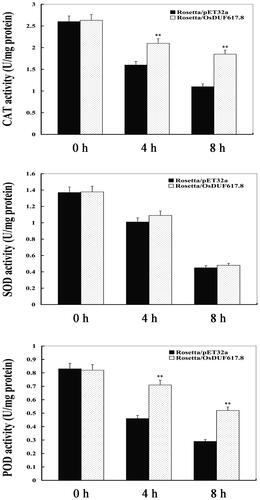
Discussion
OsDUF617 family members play different roles
Here eight members of OsDUF617 are distributed on seven chromosomes. It has been reported that the rice genome includes 10 duplicated blocks accounting for 45% of its total size [Citation36]. It is possible that the distribution of OsDUF617 family members to different rice chromosomes could be explained by these large segment duplications, similar to that previously suggested for OsDUF866, OsDUF946, OsDUF936, OsDUF829 and OsDUF1191 family members [Citation37–41].
In general, members of the same gene family have similar trends under the same abiotic stress conditions [Citation42,Citation43]. However, in this study we found that the eight members of OsDUF617 family in rice displayed greatly distinct expression patterns under various stress conditions and ABA treatment (). We thus suggest that OsDUF617 family members may play different roles in response to various stresses.
OsDUF617.8 improved osmotic stress resistance in transgenic E. coli
Production of reactive oxygen species (ROS) is a frequent event in organisms when they are subjected to abiotic stresses, such as drought and salinity [Citation44,Citation45], and ROS production can cause oxidative damage on membrane lipids and perturbation of cell membrane function [Citation46]. It is therefore of vital importance to maintain the balance between ROS generation and ROS scavenging in cells [Citation47]. CAT, SOD and POD are important scavenging ROS enzymes in organisms [Citation8,Citation44]. In this study, according to the higher activities of CAT and POD, the extent of damage to the E. coli cells transformed with pET32a-OsDUF617.8 after osmotic stress was lower than that of the control, and the less harm led to the enhanced tolerance to osmotic stress in transgenic E. coli.
At present, the specific mechanism underlying enhanced tolerance of osmotic stress in transgenic E. coli remains unclear. One possibility is that the osmotic stress signal is strengthened in E. coli recombinants transformed with OsDUF617.8, which in turn promotes the expression of the downstream stress-related genes, including genes encoding ROS scavenging enzymes. As a result, the osmotic stress tolerance in transgenic E. coli was improved.
Conclusions
In summary, this study describes sequence information regarding the OsDUF617 family members and the expression patterns of OsDUF617 family members in different tissues, and under various abiotic stresses and ABA. OsDUF617.8 could enhance the activity of ROS scavenging enzymes and improve resistance to osmotic stress of transgenic E. coli. These data can provide important reference for further studies of the functions of the OsDUF617 family.
Disclosure statement
No potential conflict of interest was reported by the authors.
Additional information
Funding
References
- Boyer JS. Plant productivity and environment. Science. 1982;218:443–448.
- Mahajan S, Tuteja N. Cold, salinity and drought stresses: an overview. Arch Biochem Biophys. 2005; 444:139–158.
- Sahoo RK, Ansari MW, Tuteja R, et al. OsSUV3 transgenic rice maintains higher endogenous levels of plant hormones that mitigates adverse effects of salinity and sustains crop productivity. Rice. 2014;7:17.
- Wang X, Zhu W, Hashiguchi A, et al. Metabolic profiles of flooding-tolerant mechanism in early-stage soybean responding to initial stress. Plant Mol Biol. 2017;94:669–685.
- Zhu JK. Abiotic stress signaling and responses in plants. Cell. 2016;167:313–324.
- Farooq M, Wahid A, Lee DJ, et al. Advances in drought resistance of rice. Crit Rev Plant Sci. 2009;28(4):199–217.
- Zhu JK. Salt and drought stress signal transduction in plants. Annu Rev Plant Biol. 2002;53:247–273.
- Apel K, Hirt H. Reactive oxygen species: metabolism, oxidative stress, and signal transduction. Annu Rev Plant Biol. 2004;55:373–399.
- Joo J, Choi HJ, Lee YH, et al. A transcriptional repressor of the ERF family confers drought tolerance to rice and regulates genes preferentially located on chromosome 11. Planta. 2013;238:155–170.
- Saad AS, Li X, Li HP, et al. A rice stress-responsive NAC gene enhances tolerance of transgenic wheat to drought and salt stresses. Plant Sci. 2013;203/204:33–40.
- Uga Y, Sugimoto K, Ogawa S, et al. Control of root system architecture by DEEPER ROOTING 1 increases rice yield under drought conditions. Nat Genet. 2013;45:1097–1102.
- Yu L, Chen X, Wang Z, et al. Arabidopsis enhanced drought tolerance1/HOMEODOMAIN GLABROUS11 confers drought tolerance in transgenic rice without yield penalty. Plant Physiol. 2013;162:1378–1391.
- Zhu X, Xiong L. Putative megaenzyme DWA1 plays essential roles in drought resistance by regulating stress-induced wax deposition in rice. Proc Natl Acad Sci USA. 2013;110:17790–17795.
- Chen M, Zhao Y, Zhuo C, et al. Overexpression of a NF-YC transcription factor from bermudagrass confers tolerance to drought and salinity in transgenic rice. Plant Biotechnol J. 2015;13:482–491.
- Lim SD, Lee C, Jang CS. The rice RING E3 ligase, OsCTR1, inhibits trafficking to the chloroplasts of OsCP12 and OsRP1, and its overexpression confers drought tolerance in Arabidopsis. Plant Cell Environ. 2014;37:1097–1113.
- El-Gebali S, Mistry J, Bateman A, et al. The Pfam protein families database in 2019. Nucleic Acids Res. 2019;47:D427–D432.
- Bateman A, Coggill P, Finn RD. DUFs: families in search of function. Acta Crystallogr Sect F Struct Biol Cryst Commun. 2010;66:1148–1152.
- Bischoff V, Nita S, Neumetzler L, et al. TRICHOME BIREFRINGENCE and its homolog AT5G01360 encode plant-specific DUF231 proteins required for cellulose biosynthesis in Arabidopsis. Plant Physiol. 2010;153:590–602.
- Cao X, Yang KZ, Xia C, et al. Characterization of DUF724 gene family in Arabidopsis thaliana. Plant Mol Biol. 2010;72:61–73.
- Mewalal R, Mizrachi E, Coetzee B, et al. The Arabidopsis domain of unknown function 1218 (DUF1218) containing proteins, MODIFYING WALL LIGNIN-1 and 2 (At1g31720/MWL-1 and At4g19370/MWL-2) function redundantly to alter secondary cell wall lignin content. PLoS One. 2016;11:e0150254.
- Jones-Rhoades MW, Borevitz JO, Preuss D. Genome-wide expression profiling of the Arabidopsis female gametophyte identifies families of small, secreted proteins. PLoS Genet. 2007;3:1848–1861.
- He X, Hou X, Shen Y, et al. TaSRG, a wheat transcription factor, significantly affects salt tolerance in transgenic rice and Arabidopsis. FEBS Lett. 2011;585:1231–1237.
- Kim SJ, Ryu MY, Kim WT. Suppression of Arabidopsis RING-DUF1117 E3 ubiquitin ligases, AtRDUF1 and AtRDUF2, reduces tolerance to ABA-mediated drought stress. Biochem Biophys Res Commun. 2012;420:141–147.
- Luo C, Guo C, Wang W, et al. Overexpression of a new stress-repressive gene OsDSR2 encoding a protein with a DUF966 domain increases salt and simulated drought stress sensitivities and reduces ABA sensitivity in rice. Plant Cell Rep. 2014;33:323–336.
- Wang L, Shen R, Chen LT, et al. Characterization of a novel DUF1618 gene family in rice. J Integr Plant Biol. 2014;56:151–158.
- Guo C, Luo C, Guo L, et al. OsSIDP366, a DUF1644 gene, positively regulates responses to drought and salt stresses in rice. J Integr Plant Biol. 2016;58:492–502.
- Ganie SA, Pani DR, Mondal TK. Genome-wide analysis of DUF221 domaincontaining gene family in Oryza species and identification of its salinity stress-responsive members in rice. PLoS One. 2017;12:e0182469.
- Letunic I, Doerks T, Bork P. SMART: recent updates, new developments and status in 2015. Nucleic Acids Res. 2014;43:257–260.
- Chou KC, Shen HB. Cell-PLoc: a package of Web servers for predicting subcellular localization of proteins in various organisms. Nat Protoc. 2008;3:153–162.
- Tamura K, Dudley J, Nei M, et al. MEGA4: Molecular evolutionary genetics analysis (MEGA) software version 4.0. Mol Biol Evol. 2007;24:1596–1599.
- Li L, Liu C, Lian X. Gene expression profiles in rice roots under low phosphorus stress. Plant Mol Biol. 2010;72:423–432.
- Li L, Ye T, Gao X, et al. Molecular characterization and functional analysis of the OsPsbR gene family in rice. Mol Genet Genom. 2017;292:271–281.
- Livak KJ, Schmittgen TD. Analysis of relative gene expression data using real-time quantitative PCR and the 2(-Delta Delta C(T)) Method. Methods. 2001;25:402–408.
- LaVallie ER, DiBlasio EA, Kovacic S, et al. A thioredoxin gene fusion expression system that circumvents inclusion body formation in the E. coli cytoplasm. Biotechnology (N Y). 1993;11:187–193.
- Liang Y, Chen Q, Liu Q, et al. Exogenous silicon (Si) increases antioxidant enzyme activity and reduces lipid peroxidation in roots of salt-stressed barley (Hordeum vulgare L.). J Plant Physiol. 2003;160:1157–1164.
- Wang X, Shi X, Hao B, et al. Duplication and DNA segmental loss in the rice genome: implications for diploidization. New Phytol. 2005;165:937–946.
- Li L, Xie C, Ye T, et al. Molecular characterization, expression pattern, and function analysis of the rice OsDUF866 family. Biotechnol Biotechnol Equip. 2017;31(2):243–249.
- Li L, Ye T, Xu J, et al. Molecular characterization and function analysis of the rice OsDUF946 family. Biotechnol Biotechnol Equip. 2017;31(3):477–485.
- Li LH, Ye TZ, Guan Y, et al. Genome-wide identification and analyses of the rice OsDUF936 family. Biotechnol Biotechnol Equip. 2018;32(2):309–315.
- Li LH, Lv MM, Zhao L, et al. Molecular characterization and function analysis of the rice OsDUF829 family. Biotechnol Biotechnol Equip. 2018;32(3):550–557.
- Lv MM, Hou DJ, Zhang L, et al. Molecular characterization and function analysis of the rice OsDUF1191 family. Biotechnol Biotechnol Equip. 2019;33(1):1608–1615.
- Dubouzet JG, Sakuma Y, Ito Y, et al. OsDREB genes in rice, Oryza sativa L., encode transcription activators that function in drought-, high-salt- and cold-responsive gene expression. Plant J. 2003;33:751–763.
- Ito Y, Katsura K, Maruyama K, et al. Functional analysis of rice DREB1/CBF-type transcription factors involved in cold-responsive gene expression in transgenic rice. Plant Cell Physiol. 2006;47:141–153.
- Mittler R. Oxidative stress, antioxidants and stress tolerance. Trends Plant Sci. 2002;7:405–410.
- Miller G, Shulaev V, Mittler R. Reactive oxygen signaling and abiotic stress. Physiol Plant. 2008;133:481–489.
- Gechev TS, Van Breusegem F, Stone JM, et al. Reactive oxygen species as signals that modulate plant stress responses and programmed cell death. Bioessays. 2006;28:1091–1101.
- Mittler R, Vanderauwera S, Gollery M, et al. Reactive oxygen gene network of plants. Trends Plant Sci. 2004;9:490–498.

